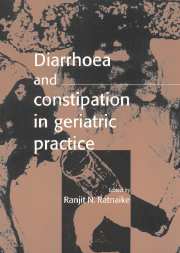Book contents
- Frontmatter
- Contents
- List of contributors
- Preface
- Acknowledgments
- Foreword by Gary R. Andrews
- I Defences of the aging gastrointestinal tract
- II Diarrhoea
- 3 Pathophysiology of diarrhoea
- 4 History and physical examination
- 5 The investigation of diarrhoea
- 6 Faecal incontinence
- 7 Drug-induced diarrhoea
- 8 Aetiology of infectious diarrhoea
- 9 Specific infectious conditions
- 10 An overview of management of infectious diarrhoea
- III Noninfectious clinical entities
- IV Constipation
- V Perspectives of altered bowel function
- Index
5 - The investigation of diarrhoea
Published online by Cambridge University Press: 17 August 2009
- Frontmatter
- Contents
- List of contributors
- Preface
- Acknowledgments
- Foreword by Gary R. Andrews
- I Defences of the aging gastrointestinal tract
- II Diarrhoea
- 3 Pathophysiology of diarrhoea
- 4 History and physical examination
- 5 The investigation of diarrhoea
- 6 Faecal incontinence
- 7 Drug-induced diarrhoea
- 8 Aetiology of infectious diarrhoea
- 9 Specific infectious conditions
- 10 An overview of management of infectious diarrhoea
- III Noninfectious clinical entities
- IV Constipation
- V Perspectives of altered bowel function
- Index
Summary
The diagnosis of diarrhoea, due to the numerous causative factors, requires a multidisciplinary investigative approach. This chapter deals with several investigative procedures and laboratory tests.
The sections in this chapter are not prioritized to reflect greater importance to a particular specialty. For example, the decision whether to first request a stool microscopy and culture to identify an enteric pathogen or to request a double contrast barium study depends on the clinical circumstances.
INVASIVE PROCEDURES
Ranjit N.Ratnaike
Sigmoidoscopy is an extremely rewarding investigation and should be regarded as mandatory before a barium enema is performed. Sigmoidoscopy may reveal the presence of a tumour, lesions suggesting inflammatory bowel disease, ulceration due to infectious colitis, or plaques characteristic of pseudomembraneous colitis. In patients with proven bacillary dysentery, sigmoidoscopy is an extremely painful procedure and is unnecessary. A high rectal swab should be sent for immediate examination if a parasitic infection, for example amoebic dysentery, is suspected.
In diarrhoea suggesting large bowel pathology (diarrhoea with blood and mucus), the choice of the initial investigation lies between a double contrast barium enema (DCBE) and colonoscopy. In a study of 76 patients with colonic disease, colonoscopy was more accurate, particularly in the diagnosis of inflammatory bowel disease, where DCBE missed the diagnosis in 9 (64 per cent) of 14 patients. The advantages of colonoscopy include the opportunities to obtain biopsies and remove polyps.
- Type
- Chapter
- Information
- Diarrhoea and Constipation in Geriatric Practice , pp. 40 - 69Publisher: Cambridge University PressPrint publication year: 1999



